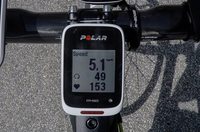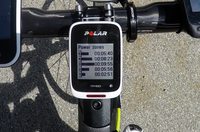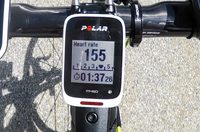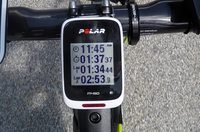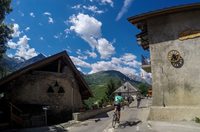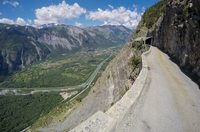Hands-on with Polar’s new M450 GPS cycling computer
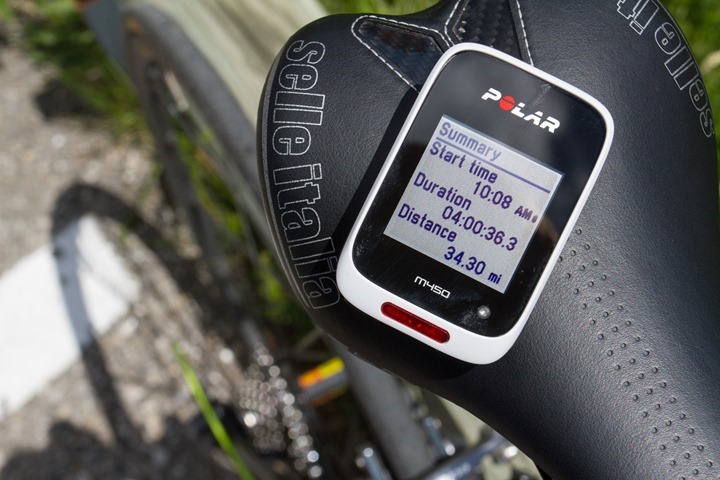
Today Polar has announced their latest cycling focused product, the M450 GPS based bike computer. In doing so, they’ve also quite likely just upended Garmin with a unit that quite frankly kicks ass (at least based on my limited testing of it). Why’s the unit such a big deal? Well, to start, it’s only $169USD/€159 (Price updated +$10USD). Yet, it has the majority of functions found in bike computers nearly $100 more in price.
Additionally, they’ve also announced that a free update will come to their existing Polar V650 bike computer, giving it mapping capabilities that allow you to actually see where you are and plan where you’re going. With that they enter the sparsely populated bike-computer-with-maps field, where there are few options.
Finally, they’ve announced a date for when Strava integration will occur with their online Polar Flow training log platform. With that, let’s dive into the details.
Overview of the M450:
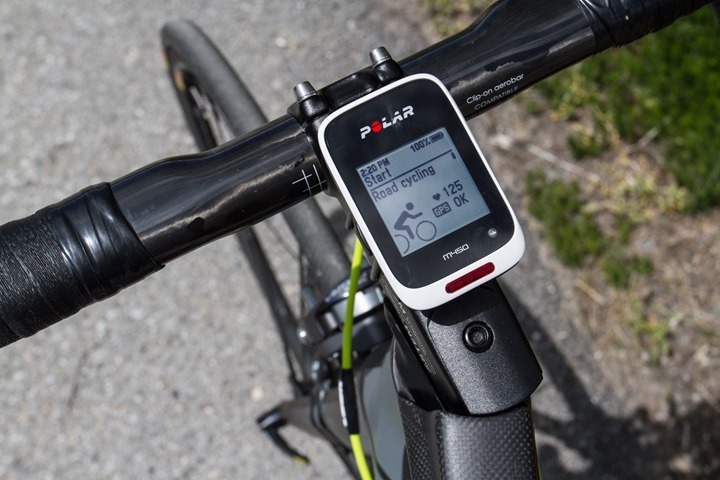
The M450 is designed to be a mid-range GPS bike computer, similar in thinking to Polar’s very popular M400 running GPS watch. Yet, in many ways both of these products compete across numerous ranges. From a price-standpoint, they are priced at the low end – almost budget-pricing. Yet feature-wise they supersede mid-range offerings and arrive closer to high-end units.
Starting with the outside, the unit is slightly bigger (length) than the iconic Garmin Edge 500, yet comparable in width. Meanwhile, it’s thinner than the Edge 500 is – minus the mount.
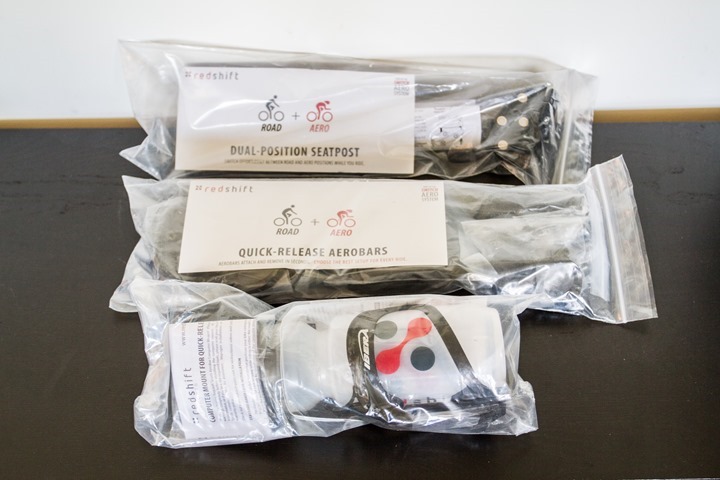
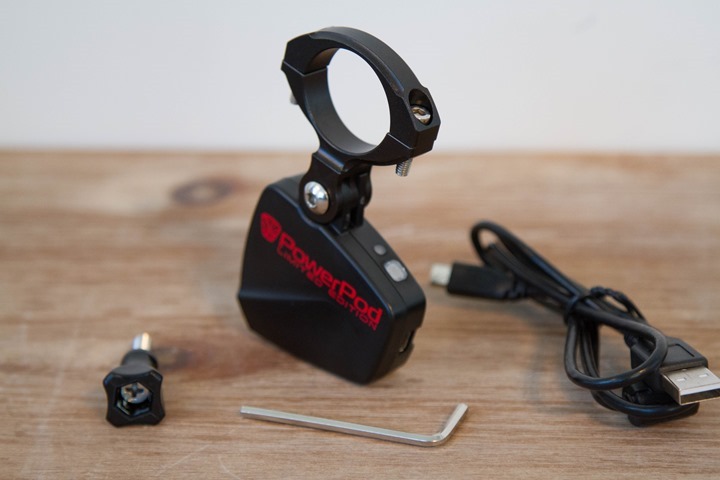
As we look at the screen, the contrast is super-sharp, with virtually no reflection visible. I had no problems reading it in the sun, as well as the shade:
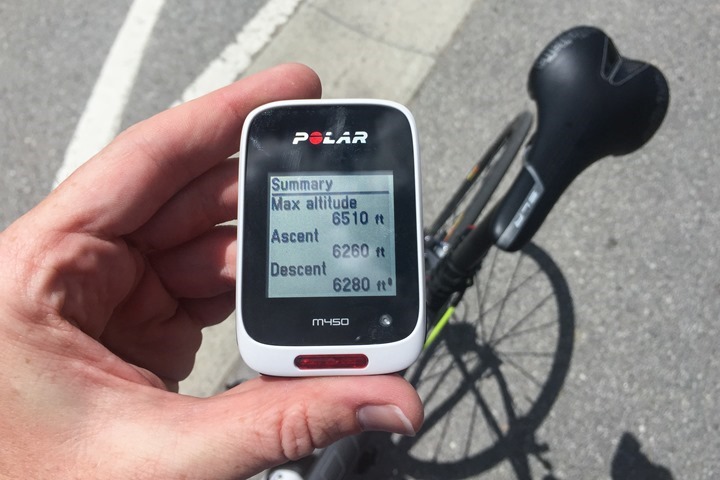
It also contains a backlight, in the event you’re riding in the darker part of the day. Similarly, it has a ‘safety light’ on the front – though like the V650 that’s semi-questionable in terms of value or if there’s much safety protection there at all. I suppose it’s probably more valuable for the daytime ride where you need to briefly transit a dark tunnel. The light will automatically turn on based on the ambient light sensor on the top of the M450:
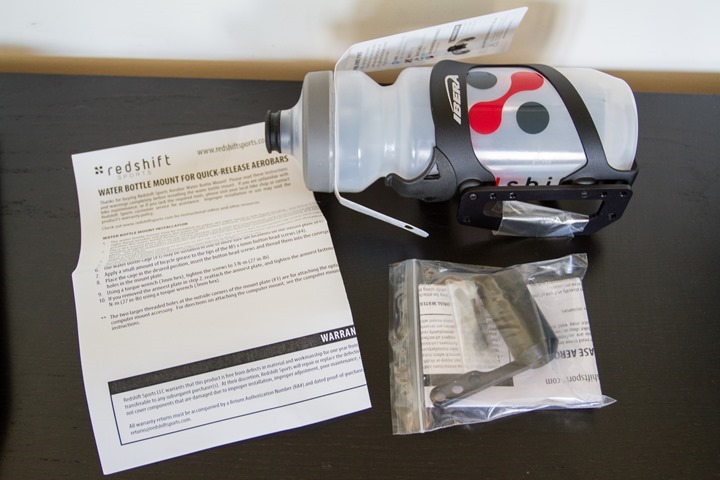
When it comes to mounting, it uses the same twist-lock system as the Polar V650. This mount is NOT compatible with Garmin quarter-turn mounts unfortunately (trust me, I’ve tried). This is unfortunate since there’s a huge swath of 3rd party companies (Barfly/K-Edge/etc…) that make awesome 3rd party mounts, none of which will work:
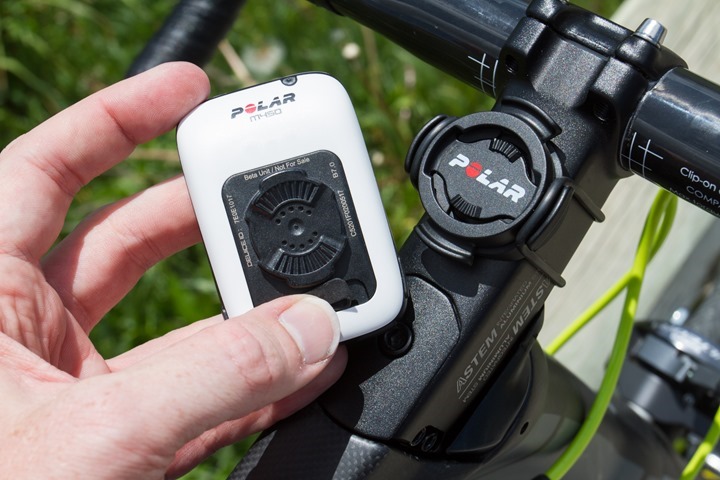
You’ll notice however that the M450 does have a very slight upwards angle to it, only really seen when laid on a flat surface. This is actually sorta brilliant – as it slightly tilts the screen towards you. Most folks prefer a slight tilt to make visibility cleaner:
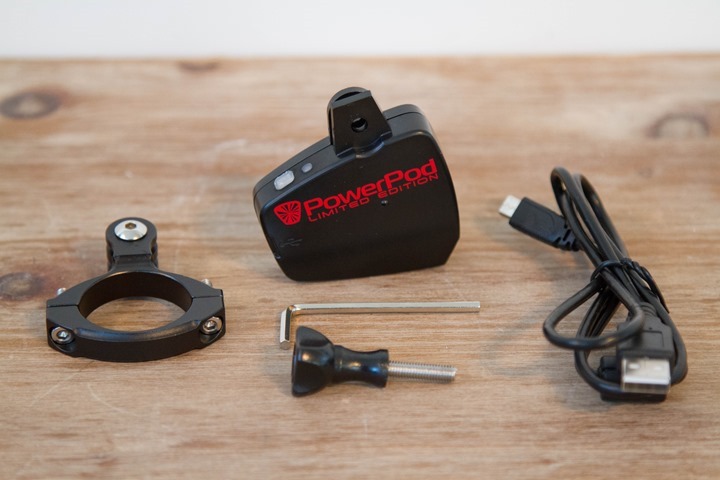
For charging, you’ll plug into the micro-USB port on the bottom, which is internally waterproofed to IPX7 standards.
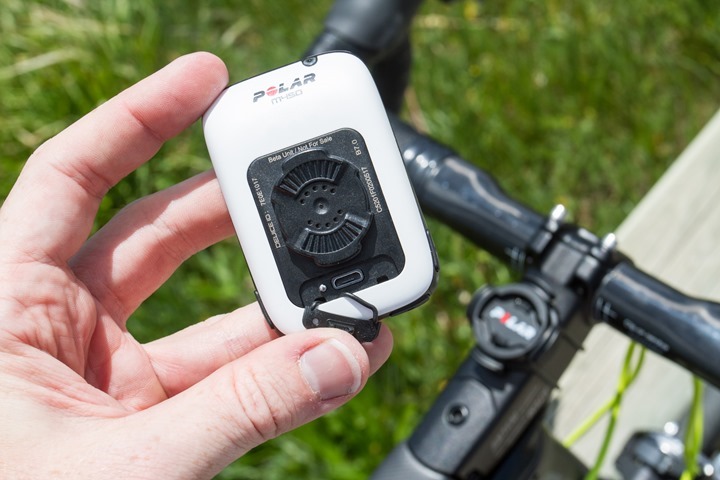
The unit allows you to create multiple ride and bike profiles. The ride profiles are created on Polar Flow, such as ones for road cycling and mountain biking:

These are then transferred to the device via either USB or Bluetooth Sync (mobile phone on iOS or Android):
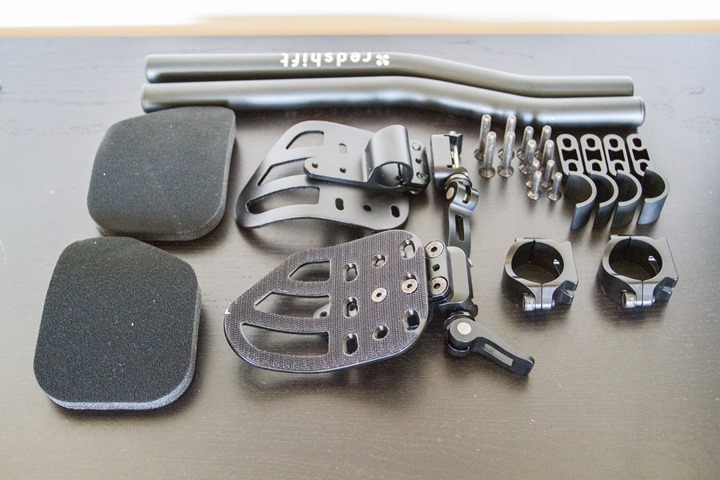
Once on the device, you’ll interact with it using a series of buttons on the bottom and lower sides. The left-side button is for turning it on, and then on the bottom left is a button that acts like the ‘Back’ key. On the right/right-bottom side you have your navigation buttons (up/down). And finally, on the top you have the selection button (red):
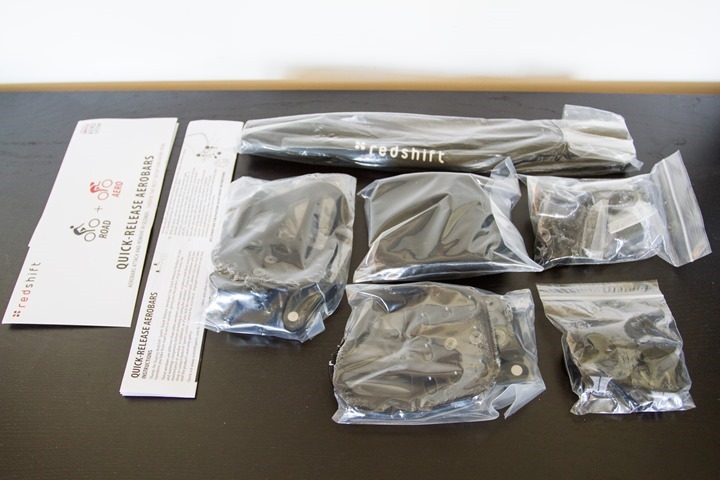
This all seems to work fairly well, at least in the summer sans-gloves. The buttons are a bit small, but given they ‘split the difference’ between the side/bottom of the device, it’s easy enough to differentiate. But I reserve the right to re-think my position after testing with some fluffier winter gloves.
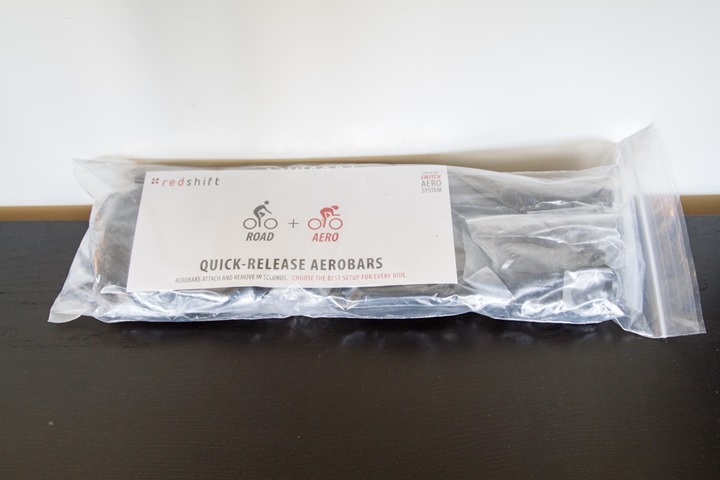
The unit by default has a white removable back plate. But Polar will be making available a variety of back plates, including ones in yellow, pink, black, a teal color and others.
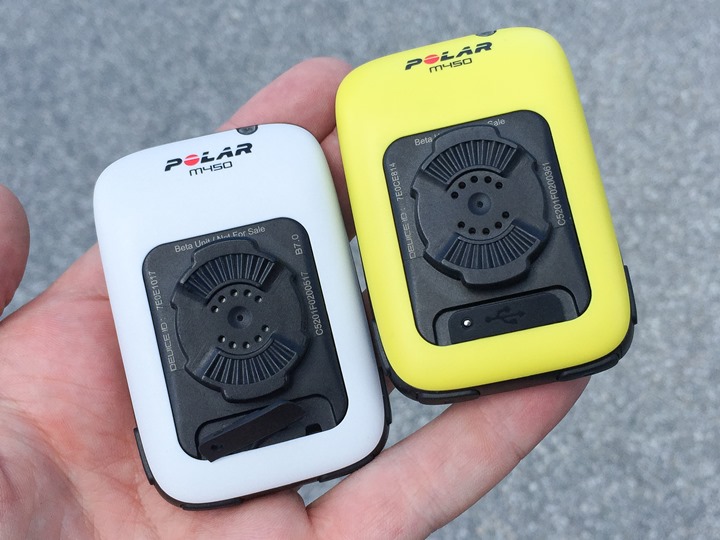
Finally, from an overview standpoint the unit includes many of the same features found on the M400 running watch. So this means you get heart-rate variability dependent metrics like Training Benefit, Orthostatic and Fitness Tests, as well as Training Load and Recovery Time. The majority of these do require the use of a heart rate strap however.
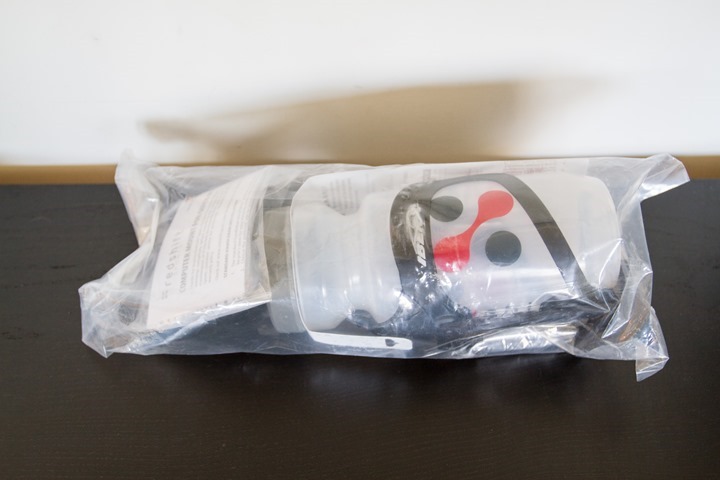
For the low-down on technical specs, here’s some of the key hardware items:
– Battery life: 12-17 hours
– GPS Chipset: U-blox UBX-G7020-CT GPS chip (PLK)
– Mount: Polar twist-lock mount (same as V650)
– Recording Time: 35 hours
– Waterproofing: IPX7
– GPS Recording Rate: 1-second
– Barometric altimeter included
– Black/white display with backlight
– Sensor Compatibility: Bluetooth Smart Power Meters (some), Bluetooth Smart Speed, Cadence, Heart Rate Sensors
Now, you’ll notice that Polar is lacking ANT+ compatibility, which is key for many power meter users – as most power meters on the market today are ANT+. This won’t come as a surprise to most readers here, given Polar’s lack of ANT+ compatibility on any products to date. At the press event, they explained this when asked by a journalist:
“There’s one very basic simple reason that we’re not using ANT+: That it’s owned by [Garmin]”.
Polar also argued that many newer power meters are coming with dual ANT+/Bluetooth Smart – which is true in theory. Stages for example, does so today. But the remainder are still in the ‘shipping barely/soon’ status – such as new dual caps from PowerTap and 4iiii. And that further ignores the huge numbers of units out in the market.
It was actually somewhat interesting at the press conference as to how much of a grilling Polar officials received over this topic from the 30+ journalists there [grilling would be a very polite way of putting it]. Many (privately and publically) argued that without ANT+ support Polar was ignoring vast segments of the market, which is definitely the case. It’s also somewhat interesting that the counter-argument from Polar was that consumers could use dual-chipset products. When in reality, so could Polar.
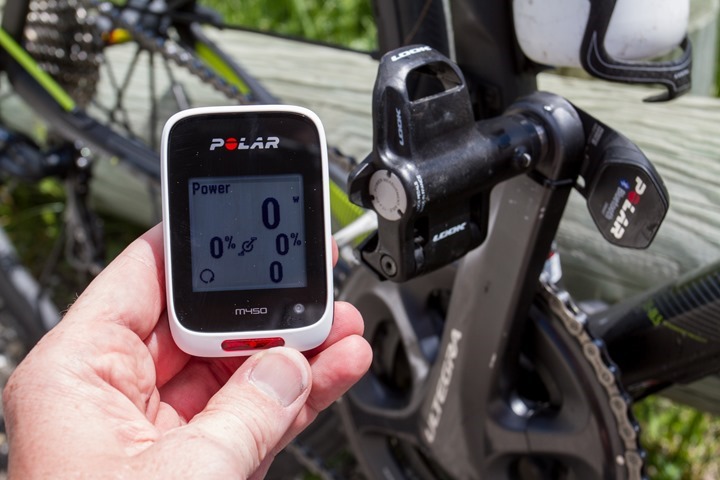
Plenty of competitors of Garmin use ANT+ without issue (and in cases like PowerTap and Mio – they also offer dual products too). And even in the case of Bluetooth Smart, Polar’s power meter support is anything but ideal. For example, it doesn’t work with the PowerTap power meters, and only last month started working with non-Polar Bluetooth Smart units.
I’m a huge fan of dual ANT+/Bluetooth Smart chipsets in products – be it on the sensor side or the head unit side. Consumer choice is ideal. To that end, I don’t think Polar realizes how much this is cutting into their potential market share of the M450 (or the V650). Despite 30-something of the most in-tuned sports tech journalists in the room trying to tell them that (and countless consumers).
Of course, the real question one could posit is which communications chipset are they using in the M450? It’s more than likely that Polar is actually using a chipset that could be dual ANT+/BLE, as that’s what most companies use today in their products. In which case, it would just be a simple firmware update. Perhaps they’ll listen to consumers more than journalists.
A Four Hour Ride:
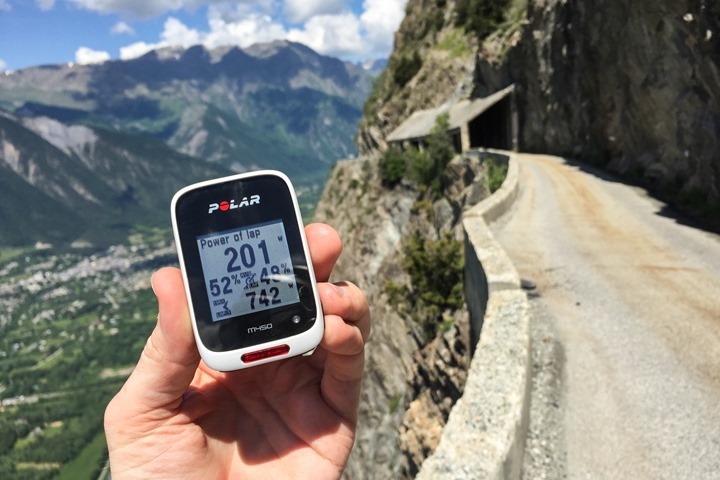
Polar had organized an event at Alpe d’Huez from Monday till Wednesday, which encompassed a number of rides – including the biggie: The famed Alpe d’Huez road climb. Unfortunately, due to existing travel plans I was only able to attend for a short period, but was able to get that one all-important ride in.
As is the usual, I pay all my own travel costs to these press events, which in this case was just a quick train ride and then a rental car from Paris, plus a hotel for the night.
I’ve been to Alpe d’Huez a number of times before – for both winter (skiing) and summer adventures. For example, last year I did the Alpe d’Huez triathlon, which included the climb. And the year prior we watched the famous double-climb-day at the Tour de France. That said, I was looking forward to the ride itself (non-tech focused) as it was a different route, which I’ll cover in more detail in a more fun post tomorrow.
The ride was organized as a large group ride, with Polar providing the bikes, as well as the head units (M450 and V650). Some in the group upped the ante with two devices at once. Aww…how cute!
Meanwhile, I was armed with all the gear I could possibly imagine. Or at least, as much as I could fit on my borrowed bike and still maintain forward movement up the 14% climbs. Below, what I concocted:
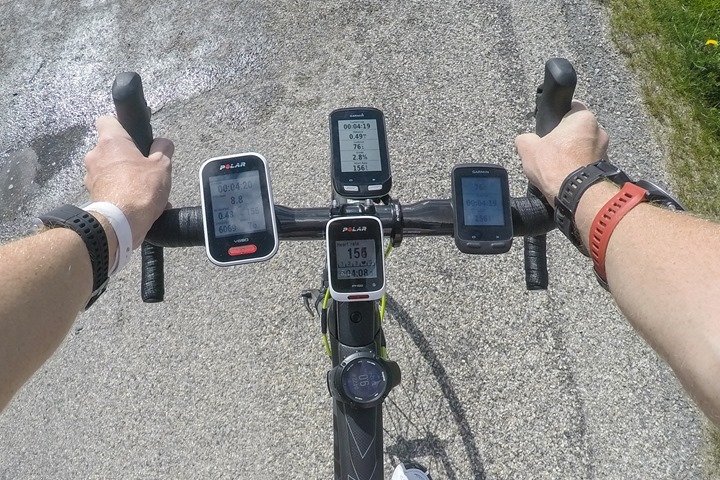
For those curious, here’s the low-down on what I rode with:
Handlebars: Polar V650, Polar M450, Garmin Edge 1000, Garmin Edge 510
Bike Frame: Suunto Ambit3 Peak, 2xSony 1000V action cams
Wrists: Polar V800, Garmin Epix, Garmin Fenix3, Apple Watch
Back Pocket: GoPro Hero4 Silver and a crapton of batteries
Sensors: Polar Power Bluetooth Smart Meter Pedals, Polar H7, Wahoo RPMv2, Scosche Rhythm+
For those curious on why I didn’t just bring my own bike with more power meters, the reasoning is two-part. First, I was super-tight on time. I barely made my train back to Paris by 3 minutes. Breaking down a bike was something I was concerned about time-wise. Second, I wasn’t really testing power meters per se, so the focus was on everything else. There’s a massive amount of prep-time that goes into ensuring testing 12+ devices at once works perfectly, and even then sometimes an item will slip by. Adding four power meters to validate/calibrate/etc would have probably pushed me over the edge.
In any case, off onto the ride I went. Tomorrow I’ll cover all the ride aspects, but here’s a quick video I put together in the meantime that I put together from before the ride, during the ride twice, at the end of the ride, and then analyzing the data after the ride. It’s like a McDonalds Happy Meal all in one video:
When it comes to the overall flow of the unit, the user interface mirrors that of the Polar M400 running watch and V800 triathlon watch. So you’ll find the menu system nearly identical. This means things like sensor pairing and the like are all in the same spots, as are functions like transferred structured workouts from Polar Flow.
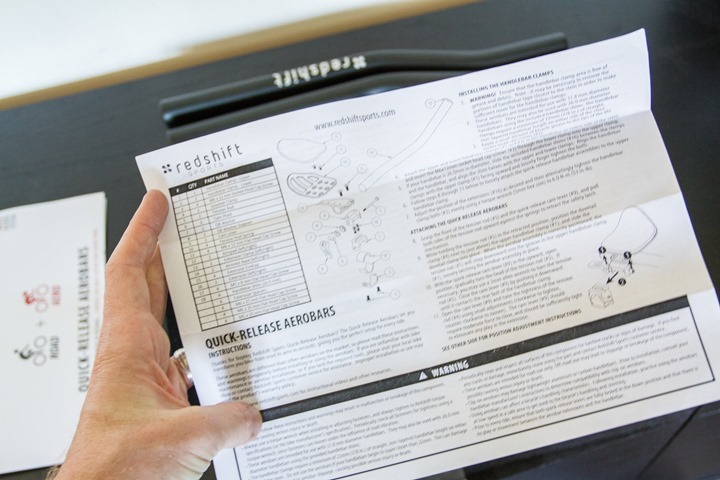
When you pair a sensor, you’ll also be able to assign it to a specific bike – thus creating bike profiles.
While the video covers many of the main features during use, I’ve put together a bit of a gallery of shots I took during the day showing many of the different screens:
Of course, it’s all about the data! For those that want to see my ride, I’ve uploaded it to Strava here. I would share a direct link to Polar Flow, but the M450 is tied to Polar’s private test site, for which I don’t have a way to share a public link.
Nonetheless, I’ve done one better – I’ve combined all of the GPS devices I was using into one cohesive bucket that you can zoom in and compare all the GPS tracks and elevation differences. This is using the MyGPSFiles site. If you click on the image below, it’ll take you to that site. The site also allows you to download the raw files, should you want to dive into the analytics a bit more in other tools.

First up, looking at the elevation graphs, I see all units tracked brilliantly. All of these units had barometric altimeters, and I had calibrated them all at the start of the ride against a sign-post in the village (1,794m = 5,886ft):
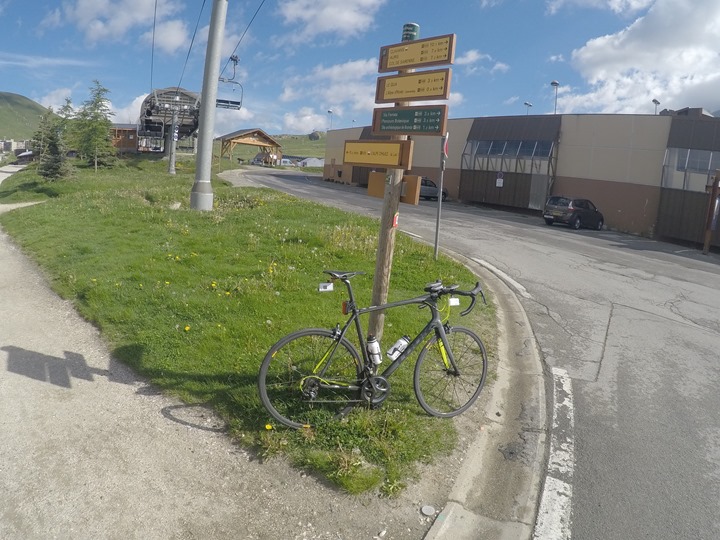
And by ‘calibrated them all’, I mean – calibrated them all except the M450, which I somehow forgot to do until about an hour into the ride at another sign-post when I calibrated it then…doh. Nonetheless, it tracked well anyway using the default calibration.

Next, looking at the GPS accuracy– overall, despite the occasionally challenging conditions, all units tracked very closely. The route itself is sometimes in wide open mountain valleys or winding through small villages, and yet other times it’s just up against massive cliff walls that rise/drop thousands of feet. Other times it’s through dense trees. Here’s four photos that best exemplify the route’s diversity:
Looking at the tracks themselves, the M450 did have a couple of brief forgetfulness moments though. Polar noted that they were still working on GPS accuracy, and given it’s a beta device and still a month or so out – it’s something they’re concentrating on. There were 3-4 cases where the M450 briefly appeared to miss an entire turn and just meander through a field (sorta like that famous Lance Armstrong field crossing in the TdF). Ironically, it did this in the lesser-challenging areas – like it just got distracted by a pretty flower or something.

Still, outside of these random divergences, things otherwise looked very good. Again, you can zoom in/out and around the track files and see how they align as you see fit, using this link:

Obviously, just one ride doesn’t make for a review, in-depth or otherwise. It’s just a data point. Albeit, a four-hour long data point in occasionally challenging conditions.
Polar V650 Mapping Update:
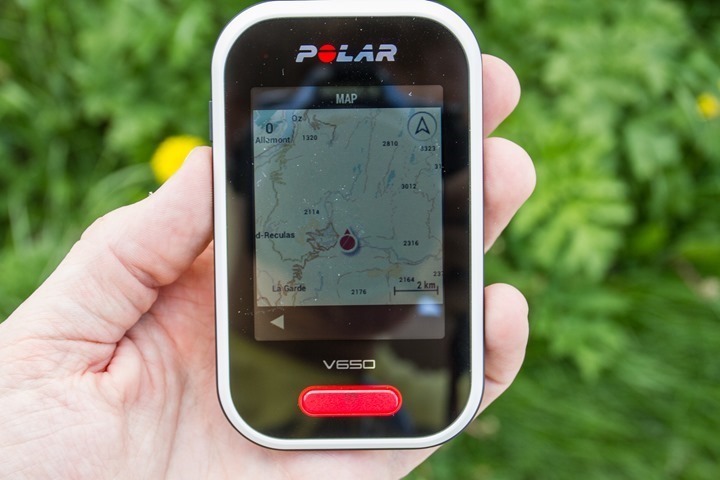
In addition to all of the new M450 news, Polar also let loose that come August, the V650 will gain mapping support. Maps will come from OpenStreet, and will be available for free for both existing and new V650 owners.
The unit will cache a 450KM by 450KM square of maps on the device itself. The way it’ll work is that you’ll use the device to zoom in on the area that you want, before selecting it.
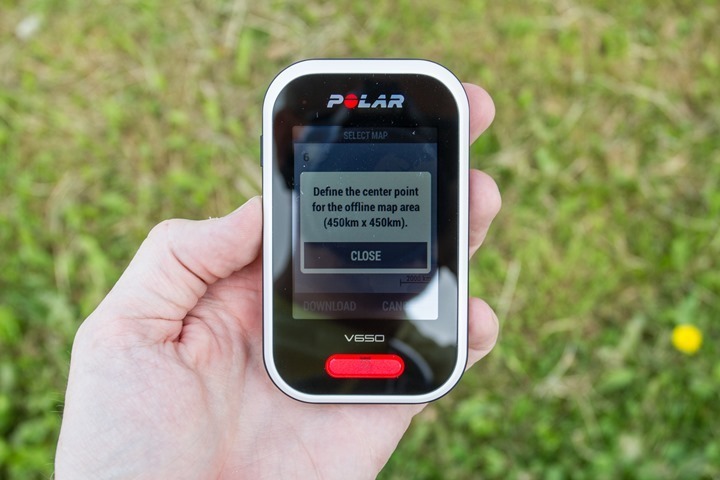
Then you’ll connect the device via USB to your computer where it’ll go off and download the maps.
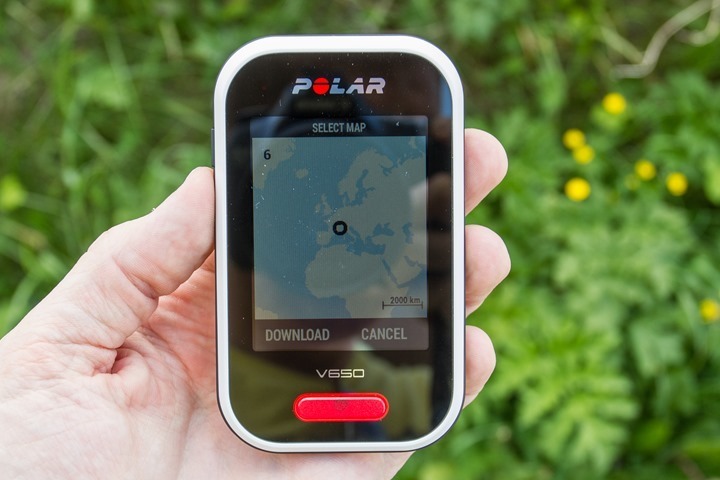
You can also specify which map layers to apply, including layers such as topographic or bike routes:
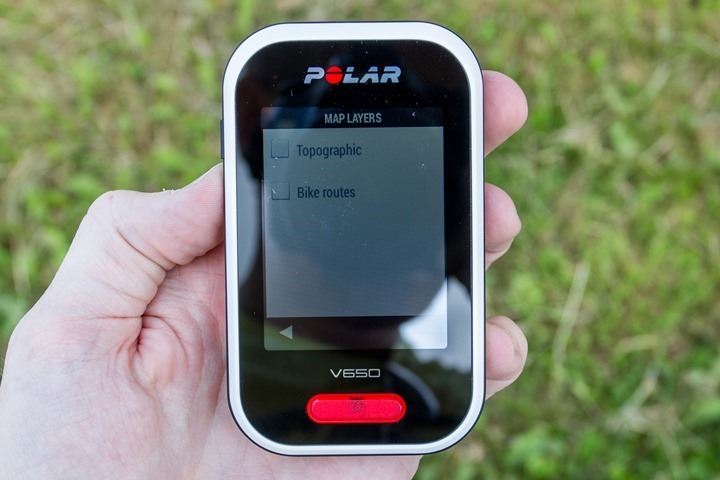
With this functionality comes the ability to navigate on a given route, pre-created on Polar Flow (Update: in August 2015 the Flow following functionality will not yet be present). Additionally, you can of course see where you are at any time and the route you took to get there. This becomes one of your data pages on the V650, just like other data pages you’ve already configured.
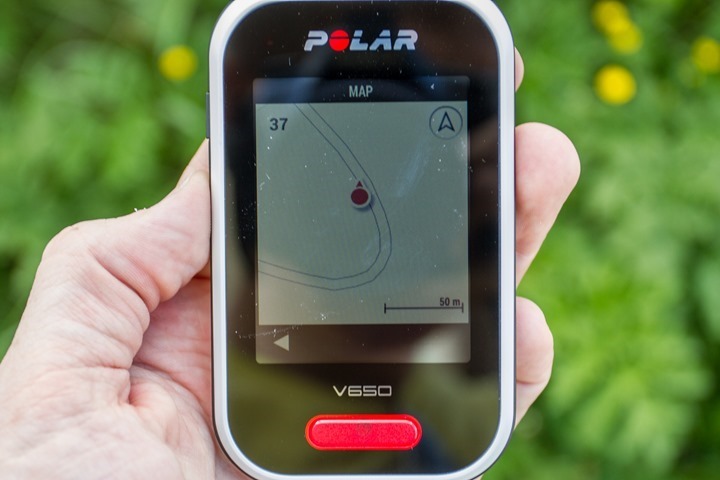
This is potentially huge news for V650 owners, especially at the price point its at today. There are still some outstanding questions that I’m awaiting clarification from Polar on though on a number of features related to this, such as exactly how deep the navigational capabilities are. I’ll update the post here with further information once I get those answers.
Update: Just for clarity, I asked about navigation. The V650 will not support putting an address in the unit (i.e. 123 Main Street). Down the road (after August), they plan to allow the user to be able to create a route on Polar flow, including importing in route files. Similarly, the unit will not load POI’s in August, but Polar is considering it for beyond that. Essentially, the main value of the map is to see your current route on it (where you’ve gone), as well as to be able to zoom and check things on the map.
Still, for a free update – I can’t see many (any?) complaining about it, even more so given that competitive units from Garmin and Mio with mapping functionality cost considerably more cash.
Strava, and other Polar Flow Updates:

In addition to announcing the M450, Polar also made a semi-expected announcement of Strava integration. Additionally, they clarified a few other Polar Flow items. That’s of course in addition to the V650 mapping announcement.
On the Strava side, Polar announced that in October they’ll introduce the ability to have your activities automatically sync to Strava from Polar Flow. This is similar to what Suunto, Garmin, Timex, and others have already implemented nearly a year ago. It essentially means you sync your device as normal, but behind the scenes Polar will send your activity file over to Strava.
While this has been rumored for some time, it’s nice to finally get a date on it. However, as many journalists in the room noted to Polar during the press event – having to wait another 4 months for said feature is sorta ridiculous. This isn’t segment support on devices or anything else fancy. It’s literally as simple as shooting Strava your .TCX files (that Polar Flow can already export).
From a web development effort perspective, this is basically old hat to Strava. They do this day in and day out with companies. In fact, Strava doesn’t really do anything in this integration, the 3rd party company (in this case, Polar) does all the work. And said work isn’t very complex either. We’re not talking months or even weeks of development time. We’re talking like one large pizza and a half-case of Mountain Dew dev-time here. Even accounting for quality assurance (QA) time, it’s mind-boggling that this will take another 4 months. Sigh. And that of course ignores other hugely popular platforms like Training Peaks and Sport Tracks, both of which operate in a similar fashion and have been eager to have Polar onboard.
In addition, they noted that by the fall timeframe they also hope to have importing of workouts from past Polar platforms into Polar Flow – a feature they’ve long since promised and keep missing on delivering.
While these updates are much appreciated, I (and many other readers) think that Polar doesn’t quite understand how important it is that they accelerate their web platform development efforts. There are countless features that have been long promised (for 18+ months) that aren’t there yet. With today’s technology integration, the software/web side of the platform is almost just as important as the device itself.
Product Comparison:
I’ve added the Polar M450 into the product comparison database. This means you can mix and match it against any other product I’ve reviewed. For the purposes of below, I’ve shown just the Polar M450, Polar V650, Garmin Edge 500.
Copyright DC Rainmaker – Updated February 19th, 2017 @ 2:20 pmNew Window
Price$169$253/€220$199
Product Announcement DateJune 4th, 2015January 26, 2014SEP 1, 2009
Actual Availability/Shipping DateJuly 2015March 2015Dec 2009
GPS Recording FunctionalityYesYesYes
Data TransferUSB/Bluetooth SmartUSBUSB
WaterproofingIPX7IPX7IPX7
Battery Life (GPS)12-17 Hours10 Hours18 hours
Recording Interval1-second1-second1-Second or Smart
Satellite Pre-Loading via ComputerYesYes – 3 DaysNo
Quick Satellite ReceptionGreatYesGreat
AlertsAudio/VisualSound/VisualSound/Visual
Backlight GreatnessGreatGreatGood
Ability to download custom apps to unit/deviceNoNoNo
Acts as daily activity monitor (steps, etc…)NoNoNo
Can control phone musicNo
Has music storage and playbackNo
Bluetooth Legacy (pre-4.0) to PhoneNoNoNo
Bluetooth Smart (4.0+) to Phone UploadingYesNot yetNo
Phone Notifications to unit (i.e. texts/calls/etc…)NoTBANo
Live Tracking (streaming location to website)NoNoNo
Emergency/SOS Message Notification (from watch to contacts)NoNoNo
Built-in cellular chip (no phone required)NoNoNo
Designed for cyclingYesYesYes
Power Meter CapableYesYesYes
Power Meter Configuration/Calibration OptionsYesYesYes
Power Meter TSS/NP/IFNoYesYes
Speed/Cadence Sensor CapableYesYesYes
Strava segments live on deviceNoNoNo
Designed for runningNoNoNo
VO2Max Estimation(For Cycling, yes)N/AN/A
Recovery Advisor(For Cycling, yes)N/AN/A
Designed for swimmingNoNoNo
Designed for triathlonNoNoNo
Create/Follow custom workoutsYesYesYes
On-unit interval FeatureYesNoYes
Training Calendar FunctionalitySortaNoNo
Auto Start/StopYesYes
Virtual Partner FeatureSortaNoYes
Virtual Racer FeatureNoNoNo
Records PR’s – Personal Records (diff than history)YesNoNo
Day to day watch abilitySortaNoN/A
Hunting/Fishing/Ocean DataNoNoNo
Tidal Tables (Tide Information)NoNoNo
Jumpmaster mode (Parachuting)NoNoNo
GeocachingNoNoNo
Weather Display (live data)NoNoNo
Follow GPS Track (Courses/Waypoints)NoPlannedYes
Markers/Waypoint DirectionNoNoYes
Routable/Visual Maps (like car GPS)NoYesNo
Back to startYesYesYes
Impromptu Round Trip Route CreationNoNoNo
Download courses/routes from phone to unitYesPlannedNo
Altimeter TypeBarometricBarometricBarometric
Compass TypeGPSGPS
Optical Heart Rate Sensor internallyNoN/ANo
Heart Rate Strap CompatibleYesYesYes
ANT+ Heart Rate Strap CapableNoNoYes
ANT+ Speed/Cadence CapableNoNoYes
ANT+ Footpod CapableNoNoNo
ANT+ Power Meter CapableNoNoYes
ANT+ Weight Scale CapableNONoNo
ANT+ Fitness Equipment (Gym)NoNoNo
ANT+ Lighting ControlNoNoNo
ANT+ Bike Radar IntegrationNoNoNo
ANT+ Trainer Control (FE-C)NoNoNo
ANT+ Remote ControlNoNoNo
ANT+ eBike CompatibilityNoNoNo
ANT+ Muscle Oxygen (i.e. Moxy/BSX)No
ANT+ Gear Shifting (i.e. SRAM ETAP)No
Shimano Di2 ShiftingNoNoNo
Bluetooth Smart HR Strap CapableYesYesNo
Bluetooth Smart Speed/Cadence CapableYesYesNo
Bluetooth Smart Footpod CapableNoNoNo
Bluetooth Smart Power Meter CapableYesYesNo
Temp Recording (internal sensor)NoYesYes
Temp Recording (external sensor)NoNoNo
Compatible with Firstbeat HR tools-TBAYes
PC ApplicationPC/MacPolar FlowsyncGarmin Express
Web ApplicationPolar FlowPolar FlowGarmin Connect
Phone AppiOS/Android-Garmin Connect Mobile (not direct to device though)
Ability to Export SettingsNoNoNo
Amazon LinkLinkLinkLink
Clever Training Link (Save 10% with DCR10BTF)LinkLinkLink
Clever Training Europe (Save 10% with DCR10BTF)LinkLink
Review LinkLinkLinkLink
Remember again that you can mix and match any products you’d like within the product comparison tool.
A Few Thoughts:
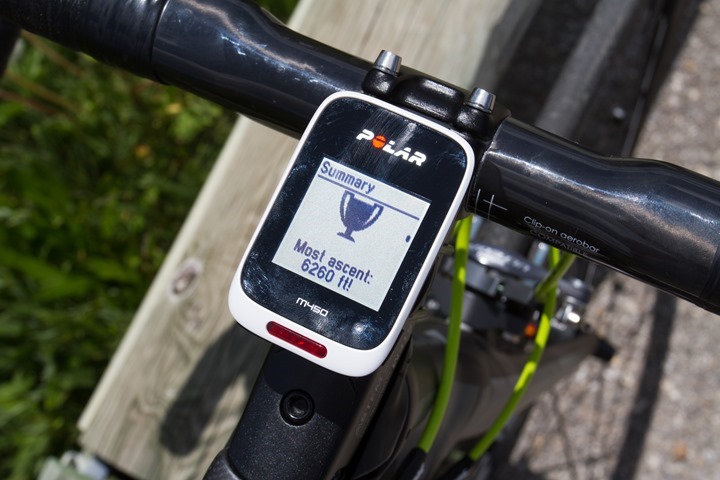
One of the things I think people enjoy about what I write here, is that I give a bit of a behind the scenes look at companies, events and products. As part of that, I thought it was worthwhile to share (another) small tidbit from the press event. During the event, a journalist asked a question about why a consumer that’s gone to Garmin, should buy the Polar M450 instead of another Garmin:
Journalist: “What are you doing to win Garmin users back?”
Polar sorta danced around the question giving a bit of a non-descript answer saying they felt that the M450 was:
Polar: “Offering the best and simplest product in the market” followed by variants of ‘You’ll see when you ride’
But when pressed for specifics on those ‘best’ claims by that journalist, they couldn’t provide specific features/functions. This then spawned another question along the same lines, which again, they didn’t have an answer for. Like a pack of hungry wolves, others pressed further – in fact, for nearly 30 minutes of open-mic questioning numerous Polar employees and PR people couldn’t give a concrete reason to buy the M450 over a Garmin Edge series device.
I found this mildly surprising – as Polar seemed unable to answer the most fundamental marketing question. Yet what was more interesting to me is that the answer was so obvious. So much so that I’ll help them with it (feel free to use this as you see fit):
Correct answer: It’s likely the best freakin’ value for the money by a long shot.
Like their Polar M400 – it’s not the absolute ‘best overall’ unit (in running as was the case then), but it’s the one that hits 90% of the market at a ~40% lower price than the nearest competitor. They took a play out of their own book from last year when they launched the M400, yet seemed unable to remember what the play was called with the M450.
With that in mind, it should likely be obvious that I’m really impressed with the unit. I’d agree with them that it’s sorta a ‘You’ll see it when you ride it’, it’s more impressive how crisp, sharp, and fast the unit is in actual use. So even if their marketing message is muddled, the actual engineering on the unit itself is very concrete.
Just like last year with Polar’s M400 running watch launch, this will completely gut out much of Garmin’s low and mid-range sales. Right now, in this size and price range Garmin only has the 6-year old Edge 500 and far less impressive Edge 200. Neither have smartphone connectivity, and neither have been updated anytime recently (for reasons that defy any logic). Only the larger and more expensive Edge 510 has the newer functions.
For power meter users however, Garmin and PowerTap’s offerings will remain the top choice, both due to ANT+ compatibility as well as data field metrics. Additionally, for those doing more complex automated workouts the M450 will likely fall short of competitive offerings (though Polar has the basics down). Additionally, for those that need more detailed mapping options than Polar will offer with the V650, Garmin will also be the go-to option there with their Edge 810/1000 series.
Still, for the vast majority of the market the M450 will be exactly what folks have been asking other companies to deliver – at a price point that far exceeds expectations: A straight forward GPS bike computer that’s accurate and well connected to the smart phone. Of course, there remains work to be done on the unit and the platform, so until they’ve finalized both those pieces – I’ll hold final judgment until my in-depth review.
Thanks for reading!
–
Update! The M450 is now available for pre-order through Clever Training, which helps support the site here. In doing so as a DCR reader you’ll save 10% using coupon code DCR10BTF, plus free US shipping. While I don’t have a final production unit yet to start the in-depth review on, once we get closer I’ll update here. That said, as noted in my post above – I’m pretty darn impressed for where it is/was in its pre-release state.
